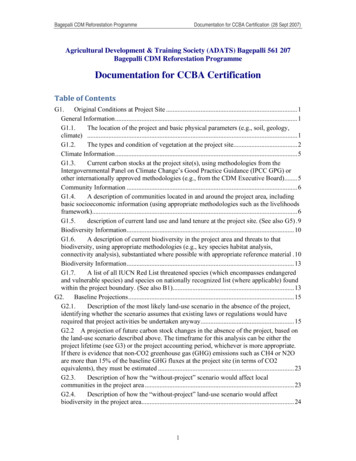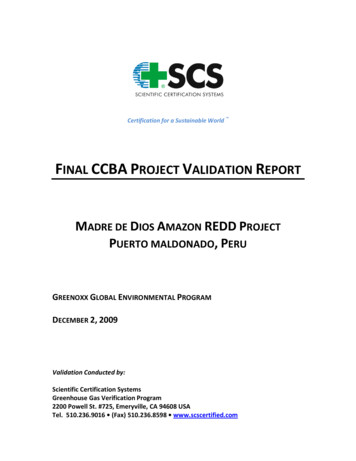
Transcription
Bagepalli CDM Reforestation ProgrammeDocumentation for CCBA Certification (28 Sept 2007)Agricultural Development & Training Society (ADATS) Bagepalli 561 207Bagepalli CDM Reforestation ProgrammeDocumentation for CCBA CertificationTable of ContentsG1.Original Conditions at Project Site . 1General Information . 1G1.1.The location of the project and basic physical parameters (e.g., soil, geology,climate) . 1G1.2.The types and condition of vegetation at the project site. 2Climate Information . 5G1.3.Current carbon stocks at the project site(s), using methodologies from theIntergovernmental Panel on Climate Change’s Good Practice Guidance (IPCC GPG) orother internationally approved methodologies (e.g., from the CDM Executive Board). 5Community Information . 6G1.4.A description of communities located in and around the project area, includingbasic socioeconomic information (using appropriate methodologies such as the livelihoodsframework) . 6G1.5.description of current land use and land tenure at the project site. (See also G5) . 9Biodiversity Information . 10G1.6.A description of current biodiversity in the project area and threats to thatbiodiversity, using appropriate methodologies (e.g., key species habitat analysis,connectivity analysis), substantiated where possible with appropriate reference material . 10Biodiversity Information . 13G1.7.A list of all IUCN Red List threatened species (which encompasses endangeredand vulnerable species) and species on nationally recognized list (where applicable) foundwithin the project boundary. (See also B1) . 13G2.Baseline Projections . 15G2.1.Description of the most likely land-use scenario in the absence of the project,identifying whether the scenario assumes that existing laws or regulations would haverequired that project activities be undertaken anyway . 15G2.2 A projection of future carbon stock changes in the absence of the project, based onthe land-use scenario described above. The timeframe for this analysis can be either theproject lifetime (see G3) or the project accounting period, whichever is more appropriate.If there is evidence that non-CO2 greenhouse gas (GHG) emissions such as CH4 or N2Oare more than 15% of the baseline GHG fluxes at the project site (in terms of CO2equivalents), they must be estimated . 23G2.3.Description of how the “without-project” scenario would affect localcommunities in the project area . 23G2.4.Description of how the “without-project” land-use scenario would affectbiodiversity in the project area . 241
Bagepalli CDM Reforestation ProgrammeDocumentation for CCBA Certification (28 Sept 2007)Description of how the “without-project” land-use scenario would affect waterG.2.5.and soil resources. (See also B5) . 26G3.Project Design & Goals . 28G3.1.Provide a description of the scope of the project and a summary of the majorclimate, community and biodiversity goals. . 28G3.2.Describe each major project activity (if more than one) and its relevance toachieving the project’s goals. . 30G3.3.Provide a map identifying the project location, where the major project activitieswill occur, and geo-referenced boundaries of the project site(s) . 33G3.4.Provide a timeframe for the project’s duration and the rationale used fordetermining the project lifetime. If the accounting period for carbon credits differs from theproject lifetime, explain . 33G3.5.Identify likely risks to climate, community and biodiversity benefits during theproject lifetime. Outline measures that the project plans to undertake to mitigate these risks. 34G3.6.Document and defend how local stakeholders have been or will be defined . 36G3.7.Demonstrate transparency by: making all project documentation publiclyaccessible at, or near, the project site; only withholding information when the need forconfidentiality is clearly justified; informing local stakeholders how they can access theproject documentation; and by making key project documents available in local or regionallanguages, where applicable. . 37G4.Management Capacity . 39G4. 1.Document the management team’s experience implementing land managementprojects. If relevant experience is lacking, the proponents must demonstrate how otherorganizations will be partnered with to support the project. . 39G4. 2.Demonstrate that management capacity is appropriate to the scale of the project40G4. 3.Document key technical skills that will be required to successfully implement theproject and identify members of the management team or project partners who possess theappropriate skills . 41G4. 4.Document the financial health of the implementing organization(s). 42G5.Land Tenure . 43G5.1.Guarantee that the project will not encroach uninvited on private property,community property, or government property . 43G5.2.Guarantee that the project does not require the relocation of people, or anyrelocation is 100% voluntary and fundamentally helps resolve land tenure problems in thearea. 44G5.3.Describe potential “in-migration” of people from surrounding areas, if relevant,and explain how the project will respond . 44G6.Legal Status . 45G6.1.Guarantee that no laws will be broken by the project . 45G6.2.Document that the project has, or expects to secure, approval from theappropriate authorities . 45G7.Adaptive Management for Sustainability . 462
Bagepalli CDM Reforestation ProgrammeDocumentation for CCBA Certification (28 Sept 2007)Demonstrate how management actions and monitoring programs are designed toG7.1.generate reliable feedback that is used to improve project outcomes . 46G7.2.Have a management plan for documenting decisions, actions and outcomes andsharing this information with others within the project team, so experience is passed onrather than being lost when individuals leave the project . 49G7.3.Demonstrate how the project design is sufficiently flexible to accommodatepotential changes and that the project has a defined process in place to adjust projectactivities as needed . 51G7.4.Demonstrate an early commitment to the long-term sustainability of projectbenefits once initial project funding expires. Potential activities may include: designing anew project that builds on initial project outcomes; securing payments for ecosystemservices; promoting micro-enterprise; and establishing alliances with organizations orcompanies to continue sustainable land management . 52G8.Knowledge Dissemination . 53G8.1.Describe how they will document the relevant or applicable lessons learned . 53G8.2.Describe how they will disseminate this information in order to encouragereplication of successful practices. Examples include: undertaking and disseminatingresearch that has wide reaching applications; holding training workshops for communitymembers from other locales; promoting “farmer to farmer” knowledge-transfer activities;linking to regional databases; and working with interested academic, corporate,governmental or non-governmental organizations to replicate successful project activities . 53CL1. Net Positive Climate Impacts. 55CL1.1. Use the methodologies of the Intergovernmental Panel on Climate Change’sGood Practice Guidance (IPCC GPG) to estimate the net change in carbon stocks due tothe project activities. The net change is equal to carbon stock changes with the projectminus carbon stock changes without the project (the latter having been estimated in G2).Alternatively, any methodology approved by the CDM Executive Board may be used. Thisestimate must be based on clearly defined and defendable assumptions about how projectactivities will alter carbon stocks and non-CO2 GHG emissions over the duration of theproject or the project accounting period. . 55CL1.2. Factor in the non-CO2 gases CH4 and N2O to the net change calculations(above) if they are likely to account for more than 15% (in terms of CO2 equivalents) ofthe project’s overall GHG impact. . 57CL1.3. Demonstrate that the net climate impact of the project (including changes incarbon stocks, and non-CO2 gases where appropriate) will give a positive result in terms ofoverall GHG benefits delivered. . 57CL2. Offsite Climate Impacts (“Leakage”) . 59CL2.1. Estimate potential offsite decreases in carbon stocks (increases in emissions ordecreases in sequestration) due to project activities. . 59CL2.2. Document how negative offsite impacts resulting from project activities will bemitigated, and estimate the extent to which such impacts will be reduced. . 60CL2.3. Subtract any likely project-related unmitigated negative offsite climate impactsfrom the climate benefits being claimed by the project. The total net effect, equal to the netincrease in onsite carbon stocks (calculated in the third indicator in CL1) minus negativeoffsite climate impacts, must be positive. . 603
Bagepalli CDM Reforestation ProgrammeDocumentation for CCBA Certification (28 Sept 2007)CL3. Climate Impact Monitoring. 62CL3.1. Have an initial plan for how they will select carbon pools and non-CO2 GHGs tobe monitored, and the frequency of monitoring. Potential pools include abovegroundbiomass, litter, dead wood, belowground biomass and soil carbon. Pools to monitor mustinclude any pools expected to decrease as a result of project activities. Relevant non-CO2gases must be monitored if they account for more than 15% of the project’s net climateimpact expressed in terms of CO2 equivalents. . 62CL4. Adapting to Climate Change and Climate Variability . 69CL4.1. Identify likely regional climate change and climate variability impacts, usingavailable studies. . 69CL4.2. Demonstrate that the project has anticipated such potential impacts and thatappropriate measures will be taken to minimize these negative impacts. . 69CL5. Carbon Benefits Withheld from Regulatory Markets . 73CL5.1. Not sell at least 10% of the total carbon benefits generated by the project intoregulated GHG markets (e.g. CDM, New South Wales GHG Abatement Scheme, OregonStandard). Projects can sell these carbon benefits in a voluntary market or retire them. . 73CM1.Net Positive Community Impacts . 75CM1.1. Use appropriate methodologies (e.g. the livelihoods framework) to estimate thenet benefits to communities resulting from planned project activities. A credible estimateof net benefits must include changes in community wellbeing given project activities. Thisestimate must be based on clearly defined and defendable assumptions about how projectactivities will alter social and economic wellbeing over the duration of the project. The“with project” scenario must then be compared with the baseline scenario of social andeconomic wellbeing in the absence of the project (completed in G2). The difference (i.e.,the net community benefit) must be positive. . 75CM1.2. Document local stakeholder participation in the project’s planning. If the projectoccurs in an area with significant local stakeholders, the project must engage a diversity ofstakeholders, including appropriate sub-groups, underrepresented groups and women livingin the project vicinity. Stakeholders in the project’s area of influence must have anopportunity before the project design is finalized, to raise concerns about potential negativeimpacts, express desired outcomes and provide input on the project design. Projectdevelopers must document stakeholder dialogues and indicate if and how the projectproposal was revised based on such input. . 78CM1.3. Formalize a clear process for handling unresolved conflicts and grievances thatarise during project planning and implementation. The project design must include aprocess for hearing, responding to and resolving community grievances within areasonable time period. This grievance process must be publicized to local stakeholders.Project management must attempt to resolve all reasonable grievances raised, and providea written response to grievances within 30 days. Grievances and project responses must bedocumented. . 83CM2.Offsite Community Impacts . 85CM2.1. Identify potential negative offsite community impacts that the project is likely tocause. 85CM2.2. Describe how the project plans to mitigate these negative offsite social andeconomic impacts. 864
Bagepalli CDM Reforestation ProgrammeDocumentation for CCBA Certification (28 Sept 2007)CM2.3. Evaluate likely unmitigated negative offsite social and economic impacts againstthe social and economic benefits of the project within the project boundaries. Justify anddemonstrate that the net social and economic effect of the project is positive. . 87CM3.Community Impact Monitoring . 88CM3.1. Have an initial plan for how they will select community variables to bemonitored, and the frequency of monitoring. Potential variables include income, health,roads, schools, food security, education and inequality. Community variables at risk ofbeing negatively impacted by project activities should be monitored. . 88CM4.Capacity Building . 90CM4.1. Structured to accommodate the needs of communities, not only of the project, . 90CM4.2. Targeted to a wide range of groups, not just elites . 90CM4.3. Targeted to women to increase their participation . 91CM4.4. Aimed to increase community participation in project implementation . 91CM5.Best Practices in Community Involvement. 93CM5.1. Demonstrate that the project was developed with a strong knowledge of localcustoms and that, where relevant, project activities are compatible with local customs. . 93CM5.2. Show that local stakeholders will fill all employment positions (includingmanagement) if the job requirements are met. Project proponents must explain howstakeholders will be selected for positions and where relevant, must indicate howtraditionally underrepresented stakeholders and women, will be given a fair chance to fillpositions for which they can be trained. . 94CM5.3. Show that the project will inform workers about their rights, and that the projectcomplies with international rules on worker rights. 94CM5.4. Comprehensively assess situations and occupations that pose a substantial risk toworker safety. A plan must be in place to inform workers of risks and to explain how tominimize such risks. Where worker safety cannot be guaranteed, project proponents mustshow how the risks will be minimized using best work practices. . 95B1.Net Positive Biodiversity Impacts . 96B.1.1.Use appropriate methodologies (e.g. key species habitat analysis, connectivityanalysis) to estimate changes in biodiversity as a result of the project. This estimate mustbe based on clearly defined and defendable assumptions. The “with project” scenarioshould then be compared with the baseline “without project” biodiversity scenariocompleted in G2. The difference (i.e., the net biodiversity benefit) must be positive. . 96B1.2.Describe possible adverse effects of non-native species on the area’senvironment, including impacts on native species and disease introduction or facilitation. Ifthese impacts have a substantial bearing on biodiversity or other environmental outcomes,the project proponents must justify the necessity of using non-native species over nativespecies. . 96B1.3.Identify all IUCN Red List threatened species and species deemed threatened onnationally recognized lists that may be found within the project boundary. Projectproponents must document how project activities will not be detrimental in any way tothese species. . 100B1.4.Identify all species to be used by the project and show that no known invasivespecies will be used. . 1005
Bagepalli CDM Reforestation ProgrammeDocumentation for CCBA Certification (28 Sept 2007)Guarantee that no genetically modified organisms will be used to generateB1.5.carbon credits. . 100B2.Offsite Biodiversity Impacts . 101B2.1.Identify potential negative offsite biodiversity impacts that the project is likely tocause. 101B2.2.Describe how the project plans to mitigate these negative offsite biodiversityimpacts. . 101B2.3.Evaluate likely unmitigated negative offsite biodiversity impacts against thebiodiversity benefits of the project within the project boundaries. Justify and demonstratethat the net effect of the project on biodiversity is positive. . 101B3.Biodiversity Impact Monitoring . 102B3.1.Have an initial plan for how they will select biodiversity variables to bemonitored, and the frequency of monitoring. Potential variables include species abundanceand diversity, landscape connectivity, forest fragmentation, habitat area and diversity, etc.Biodiversity variables at risk of being negatively impacted by project activities should bemonitored. . 102B4.Native Species Use . 103B5.Water and Soil Resource Enhancement . 104B5.1.Identify project activities that are likely to enhance water and soil resources. 104B5.2.Credibly demonstrate that these activities are likely to improve water and soilresource compared to the baseline, using justifiable assumptions about cause and effect,and relevant studies. . 1046
Bagepalli CDM Reforestation ProgrammeDocumentation for CCBA Certification (28 Sept 2007)Agricultural Development & Training Society (ADATS) Bagepalli 561 207Bagepalli CDM Reforestation ProgrammeDocumentation for CCBA CertificationG1.ORIGINAL CONDITIONS AT PROJECT SITECONCEPTThe original conditions at the project site before the project commences must be described.This description, along with projections (G2), will help determine the likely impacts of theproject.INDICATORSThe project proponents must provide a description of the project site, containing all the following information:1. The location of the project and basic physical parameters (e.g., soil, geology, climate)2. The types and condition of vegetation at the project site3. Current carbon stocks at the project site(s), using methodologies from the Intergovernmental Panel on Climate Change’s Good Practice Guidance (IPCC GPG) or otherinternationally approved methodologies (e.g., from the CDM Executive Board)4. A description of communities located in and around the project area, including basicsocioeconomic information (using appropriate methodologies such as the livelihoodsframework)5. A description of current land use and land tenure at the project site. (See also G5)6. A description of current biodiversity in the project area and threats to that biodiversity, using appropriate methodologies (e.g., key species habitat analysis, connectivityanalysis), substantiated where possible with appropriate reference material.7. A list of all IUCN Red List threatened species (which encompasses endangered andvulnerable species) and species on nationally recognized list (where applicable) foundwithin the project boundary. (See also B1)GENERAL INFORMATIONG1.1. THE LOCATION OF THE PROJECT AND BASIC PHYSICAL PARAMETERS (E.G., SOIL, GEOLOGY,CLIMATE)ADATS is a rural development NGO that works in 5 taluks of North Kolar district of Karnataka State, South India.The region is a semi arid drought prone one with low, erratic and spatial rainfall. The dustbrown rocky terrain is severely undulating, with small hill ranges and outcrops that stud thetopography. There is no mineral wealth and only a very thin and fragile soil cover.1
Bagepalli CDM Reforestation ProgrammeDocumentation for CCBA Certification (28 Sept 2007)ADATS has a presence in 65% of the villages and a coverage of 18% of the total populationof the 5 taluks that comprise North Kolar District.1An adverse land : person ratio creates a strong thirst for cultivable land since less than onehalf of the total land is fit for cultivation, with the remaining taken over by the hills and rockyfields. Hardly 5% of the cropped lands are irrigated by an age old network of rain-fed irrigation tanks (small lakes), each irrigating 2 to 10 hectares of wet land. The low water table istapped through bore-wells drilled to more than 300 meters depth. Even these dry up in the hotsummer months, from March to September every year, when temperatures rise to a dry heatof 36 Celsius.The average rainfall is 560 mm a year and this is, moreover, erratic and spatial. As a resultthere is only 1 rain-fed crop a year, whose stand is from June/July till November/December.Groundnuts are grown on these dry lands, inter-cropped with red gram, cowpea, field beans,green gram, jowar, maize and castor on the field bunds. Irrigated groundnut, mulberry, onions and sunflower are the common bore-well irrigated crops. Ragi (golden millet) and acoarse variety of paddy are cultivated under irrigation tanks.Every fifth or sixth year is a drought, followed by near famine conditions. This pattern ischanging for the worse, with the region just having witnessed 5-6 years of continuousdrought.The 5 summer months are so hot and dry that not a blade of grass grows on the fields. But theregion is dotted with small clumps of desert vegetation.Please read more at http://www.adats.com/home/geography.phpGENERAL INFORMATIONG1.2. THE TYPES AND CONDITION OF VEGETATION AT THE PROJECT SITELOWWATER AVAILABILITY:The Project area consists of immense expanse of peninsular gneisses rocks. The schistoserocks in this region are poor aquifers and yield poor quality water in very less quantity. In theabsence of major sources of water like rivers, the district depends heavily on groundwater.But the groundwater table has receded beyond 600 feet depth. This has resulted in failure ofmost bore wells and has led to high fluoride content in drinking water, causing bone, dentaland other physical deformities (Raju et al., 2004).SOILDEPLETION:The soils of Kolar district are divided into three types, viz., red, clay loam and laterite. Someblack soil patches are also seen here and there. The red loam region extends from south tonorth of the district comprising of Chickballapur, major parts of Siddalaghatta taluk. The water table in this type of soils is between 400 to 500 feet deep. The gravely soil region is foundin parts of Gudibanda and Chintamani taluks. The water table in these types of soils is between 500 to 600 feet deep. The clay loam soil is found in Chickballapur and parts of Siddalaghatta and Bagepalli. Around Siddalaghatta, lateritic masses occur irregularly distributedin disconnected patches in the form of flat topped hills. The soils in Kolar district have anormal soil reaction and here and there they tend towards alkalinity.Land degradation:1Population coverage is much higher, at 40%, in villages with functioning Coolie Sangha Units2
Bagepalli CDM Reforestation ProgrammeDocumentation for CCBA Certification (28 Sept 2007)Due to land degradation many lands are uncultivable and may only improve after intensivesoil treatment. Project activities will improve the soil by providing additional mulching material to the soil and providing shading, water retention capacity and prevention of soil erosion and surface soil runoff. As can be seen from the figure below, most of the areas in theProject area situated in the Northern part of K
Bagepalli CDM Reforestation Programme Documentation for CCBA Certification (28 Sept 2007) 1 Agricultural Development & Training Society (ADATS) Bagepalli 561 207 Bagepalli CDM Reforestation Programme Documentation for CCBA Certification Table of Contents G1.










